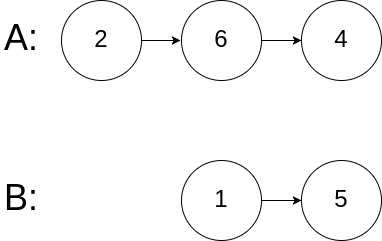[toc]
剑指 Offer 06. 从尾到头打印链表
输入一个链表的头节点,从尾到头反过来返回每个节点的值(用数组返回)。
示例 1:
输入:head = [1,3,2]
输出:[2,3,1]
限制:
0 <= 链表长度 <= 10000
利用栈
/*** Definition for singly-linked list.* public class ListNode {* int val;* ListNode next;* ListNode(int x) { val = x; }* }*/class Solution {public int[] reversePrint(ListNode head) {Deque<Integer> stack = new LinkedList<>();while (head != null) {stack.offerFirst(head.val);head = head.next;}int size = stack.size();int[] res = new int[size];int index = 0;while (!stack.isEmpty()) {res[index++] = stack.pollFirst();}return res;}}
逆向输入数组
/*** Definition for singly-linked list.* public class ListNode {* int val;* ListNode next;* ListNode(int x) { val = x; }* }*/class Solution {public int[] reversePrint(ListNode head) {ListNode curHead = head;int size = 0;while (curHead != null) {curHead = curHead.next;size++;}int[] res = new int[size];for (int i = size - 1; i >=0; i--) {res[i] = head.val;head = head.next;}return res;}}
剑指 Offer 18. 删除链表的节点
给定单向链表的头指针和一个要删除的节点的值,定义一个函数删除该节点。
返回删除后的链表的头节点。
注意:此题对比原题有改动
示例 1:输入: head = [4,5,1,9], val = 5输出: [4,1,9]解释: 给定你链表中值为 5 的第二个节点,那么在调用了你的函数之后,该链表应变为 4 -> 1 -> 9.示例 2:输入: head = [4,5,1,9], val = 1输出: [4,5,9]解释: 给定你链表中值为 1 的第三个节点,那么在调用了你的函数之后,该链表应变为 4 -> 5 -> 9.说明:题目保证链表中节点的值互不相同若使用 C 或 C++ 语言,你不需要 free 或 delete 被删除的节点
解法
用前一个节点进行比较,可以直接删除节点。还可以用一个哑巴节点做头结点,这样就不用单独判断第一个节点了。
/*** Definition for singly-linked list.* public class ListNode {* int val;* ListNode next;* ListNode(int x) { val = x; }* }*/class Solution {public ListNode deleteNode(ListNode head, int val) {ListNode pre = head;if (head.val == val) {pre = head.next;head.next = null;return pre;}while (pre.next != null) {if (pre.next.val == val) {pre.next = pre.next.next;return head;}pre = pre.next;}return null;}}
剑指 Offer 22. 链表中倒数第k个节点
输入一个链表,输出该链表中倒数第k个节点。为了符合大多数人的习惯,本题从1开始计数,即链表的尾节点是倒数第1个节点。例如,一个链表有6个节点,从头节点开始,它们的值依次是1、2、3、4、5、6。这个链表的倒数第3个节点是值为4的节点。
示例:
给定一个链表: 1->2->3->4->5, 和 k = 2.
返回链表 4->5.
快慢指针
/*** Definition for singly-linked list.* public class ListNode {* int val;* ListNode next;* ListNode(int x) { val = x; }* }*/class Solution {public ListNode getKthFromEnd(ListNode head, int k) {ListNode fast = head, slow = head;while (k-- > 0) {fast = fast.next;}while (fast != null) {fast = fast.next;slow = slow.next;}return slow;}}
剑指 Offer 24. 反转链表
定义一个函数,输入一个链表的头节点,反转该链表并输出反转后链表的头节点。
示例:输入: 1->2->3->4->5->NULL输出: 5->4->3->2->1->NULL限制:0 <= 节点个数 <= 5000
迭代解法
/*** Definition for singly-linked list.* public class ListNode {* int val;* ListNode next;* ListNode(int x) { val = x; }* }*/class Solution {public ListNode reverseList(ListNode head) {if (head == null || head.next == null) {return head;}ListNode newHead = new ListNode(-1);while (head != null) {ListNode next = head.next;head.next = newHead.next;newHead.next = head;head = next;}return newHead.next;}}
递归解法
/*** Definition for singly-linked list.* public class ListNode {* int val;* ListNode next;* ListNode(int x) { val = x; }* }*/class Solution {public ListNode reverseList(ListNode head) {if (head == null || head.next == null) {return head;}ListNode res = reverseList(head.next);head.next.next = head;head.next = null;return res;}}
剑指 Offer 35. 复杂链表的复制
请实现 copyRandomList 函数,复制一个复杂链表。在复杂链表中,每个节点除了有一个 next 指针指向下一个节点,还有一个 random 指针指向链表中的任意节点或者 null。
示例 1:

输入:head = [[7,null],[13,0],[11,4],[10,2],[1,0]]输出:[[7,null],[13,0],[11,4],[10,2],[1,0]]
示例 2:

输入:head = [[1,1],[2,1]]输出:[[1,1],[2,1]]
示例 3:

输入:head = [[3,null],[3,0],[3,null]]输出:[[3,null],[3,0],[3,null]]示例 4:输入:head = []输出:[]解释:给定的链表为空(空指针),因此返回 null。提示:-10000 <= Node.val <= 10000Node.random 为空(null)或指向链表中的节点。节点数目不超过 1000 。
解法
/*// Definition for a Node.class Node {int val;Node next;Node random;public Node(int val) {this.val = val;this.next = null;this.random = null;}}*/class Solution {public Node copyRandomList(Node head) {if (head == null) {return null;}Node ptr = head;// 将原链表每个节点旁边增加一个节点while (ptr != null) {Node newNode = new Node(ptr.val);newNode.next = ptr.next;ptr.next = newNode;ptr = newNode.next;}ptr = head;// 将复制链表的random指向对应的位置while (ptr != null) {ptr.next.random = (ptr.random != null) ? ptr.random.next : null;ptr = ptr.next.next;}// 将复制链表的next指向对应的位置Node ptrOld = head, ptrNew = head.next, newHead = head.next;while (ptrOld != null) {ptrOld.next = ptrOld.next.next;ptrNew.next = (ptrNew.next != null) ? ptrNew.next.next : null;ptrOld = ptrOld.next;ptrNew = ptrNew.next;}return newHead;}}
剑指 Offer 52. 两个链表的第一个公共节点
输入两个链表,找出它们的第一个公共节点。
如下面的两个链表:

在节点 c1 开始相交。
示例 1:

输入:intersectVal = 8, listA = [4,1,8,4,5], listB = [5,0,1,8,4,5], skipA = 2, skipB = 3输出:Reference of the node with value = 8输入解释:相交节点的值为 8 (注意,如果两个列表相交则不能为 0)。从各自的表头开始算起,链表 A 为 [4,1,8,4,5],链表 B 为 [5,0,1,8,4,5]。在 A 中,相交节点前有 2 个节点;在 B 中,相交节点前有 3 个节点。
示例 2:

输入:intersectVal = 0, listA = [2,6,4], listB = [1,5], skipA = 3, skipB = 2输出:null输入解释:从各自的表头开始算起,链表 A 为 [2,6,4],链表 B 为 [1,5]。由于这两个链表不相交,所以 intersectVal 必须为 0,而 skipA 和 skipB 可以是任意值。解释:这两个链表不相交,因此返回 null。注意:如果两个链表没有交点,返回 null.在返回结果后,两个链表仍须保持原有的结构。可假定整个链表结构中没有循环。程序尽量满足 O(n) 时间复杂度,且仅用 O(1) 内存。
解法
A和B两个链表长度可能不同,但是A+B和B+A的长度是相同的,所以遍历A+B和遍历B+A一定是同时结束。 如果A,B相交的话A和B有一段尾巴是相同的,所以两个遍历的指针一定会同时到达交点 如果A,B不相交的话两个指针就会同时到达A+B(B+A)的尾节点。
/**
* Definition for singly-linked list.
* public class ListNode {
* int val;
* ListNode next;
* ListNode(int x) {
* val = x;
* next = null;
* }
* }
*/
public class Solution {
public ListNode getIntersectionNode(ListNode headA, ListNode headB) {
ListNode l1 = headA, l2 = headB;
while (l1 != l2) {
l1 = (l1 == null) ? headB : l1.next;
l2 = (l2 == null) ? headA : l2.next;
}
return l1;
}
}
推荐阅读


